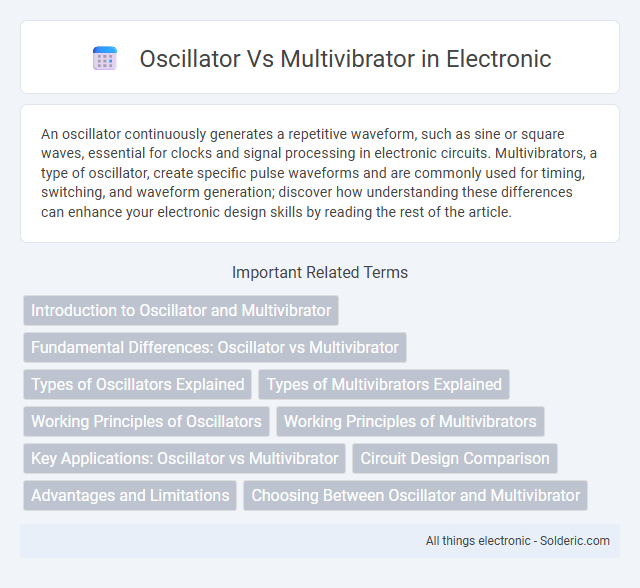An oscillator continuously generates a repetitive waveform, such as sine or square waves, essential for clocks and signal processing in electronic circuits. Multivibrators, a type of oscillator, create specific pulse waveforms and are commonly used for timing, switching, and waveform generation; discover how understanding these differences can enhance your electronic design skills by reading the rest of the article.
Comparison Table
| Feature | Oscillator | Multivibrator |
|---|---|---|
| Function | Generates continuous periodic waveforms | Produces square or rectangular pulses |
| Waveform Types | Sine wave, square wave, triangle wave | Square wave or pulse wave |
| Operation | Uses feedback to sustain oscillations | Uses bistable, monostable, or astable configurations |
| Applications | Clock generators, signal generators, RF transmitters | Timer circuits, pulse generation, flip-flops |
| Types | LC, RC, crystal oscillators | Astable, monostable, bistable multivibrators |
| Frequency Stability | High (especially crystal oscillators) | Lower, depends on component tolerances |
| Output | Continuous waveform | Pulsed waveform |
Introduction to Oscillator and Multivibrator
Oscillators generate continuous periodic waveforms such as sine or square waves, essential for timing and signal generation in electronic circuits, while multivibrators produce non-sinusoidal pulses used in switching and pulse generation. Your choice between an oscillator and a multivibrator depends on whether you require stable, continuous oscillation or intermittent pulse signals. Both components play distinct roles in electronics, influencing applications from clock pulses to waveform shaping.
Fundamental Differences: Oscillator vs Multivibrator
Oscillators generate continuous periodic waveforms, such as sine, square, or triangular waves, used for timing and signal generation in electronic circuits. Multivibrators, categorized as astable, monostable, or bistable, are pulse generators producing non-sinusoidal waveforms for switching and timing applications. Your choice depends on whether you need stable periodic signals (oscillator) or controlled pulse generation with specific timing intervals (multivibrator).
Types of Oscillators Explained
Oscillators include types such as LC, RC, and crystal oscillators, each differing in frequency stability and circuit complexity. LC oscillators use inductors and capacitors to create high-frequency signals ideal for radio applications. RC oscillators rely on resistors and capacitors for lower frequency waveforms, while crystal oscillators utilize quartz crystals to achieve precise and stable frequencies essential for timekeeping and communication devices.
Types of Multivibrators Explained
Astable, monostable, and bistable are the primary types of multivibrators, each serving distinct electronic timing and switching functions. An astable multivibrator generates a continuous square wave without any external triggering, acting as a free-running oscillator, while a monostable multivibrator produces a single output pulse in response to an input trigger. Bistable multivibrators, commonly known as flip-flops, have two stable states and toggle between them upon receiving input signals, making them essential for memory storage and digital logic circuits.
Working Principles of Oscillators
Oscillators generate continuous periodic signals by using positive feedback to sustain energy oscillations in an electronic circuit. They maintain a stable frequency determined by circuit components such as inductors, capacitors, or crystals, ensuring consistent waveform generation. Your choice between an oscillator and a multivibrator depends on the required signal stability and waveform type, as oscillators typically produce sinusoidal outputs, while multivibrators generate square or rectangular pulses.
Working Principles of Multivibrators
Multivibrators operate by rapidly switching between two unstable states to generate square wave signals, relying on the charging and discharging of capacitors through resistors to control timing intervals. Unlike oscillators that produce continuous sinusoidal waves, multivibrators produce discrete pulse outputs such as astable, monostable, or bistable waveforms useful in timing and pulse generation circuits. Their working principle hinges on feedback mechanisms within transistor or op-amp circuits to maintain stable switching cycles essential for precise frequency control.
Key Applications: Oscillator vs Multivibrator
Oscillators are essential in generating continuous periodic waveforms used in clocks, radio frequency transmitters, and signal generators. Multivibrators serve as fundamental building blocks in digital circuits for timing applications, waveform shaping, and pulse generation, including in flip-flops and timers. Oscillators focus on stable frequency generation, while multivibrators are optimized for switching and pulse timing tasks.
Circuit Design Comparison
Oscillator circuits generate continuous periodic waveforms by using positive feedback to sustain oscillations, typically involving reactive components like inductors and capacitors in designs such as LC or crystal oscillators. Multivibrators, in contrast, are digital or analog circuits primarily using transistors or logic gates to produce non-sinusoidal waveforms like square or pulse signals through switching actions between stable states. Oscillators emphasize frequency stability and waveform purity in their design, while multivibrators focus on timing accuracy and state switching, impacting component selection and circuit complexity.
Advantages and Limitations
Oscillators generate continuous periodic waveforms ideal for clock signals and RF applications, offering stable frequency output and low phase noise, but they may require precise components and tuning. Multivibrators, used for generating square or pulse waveforms, excel in digital timing and switching circuits due to simple design and ease of integration, though they typically produce less frequency stability and more distortion compared to oscillators. Selecting between oscillators and multivibrators depends on required waveform purity, frequency stability, and circuit complexity.
Choosing Between Oscillator and Multivibrator
Choosing between an oscillator and a multivibrator depends on your circuit requirements: oscillators produce continuous periodic waveforms like sine or square waves ideal for stable clock signals, while multivibrators generate specific pulse shapes, useful for timing and switching applications. Oscillators are preferred for frequency generation with low distortion, whereas multivibrators excel in monostable or astable modes for pulse width control. Your decision should align with the desired waveform stability, frequency accuracy, and application complexity.
oscillator vs multivibrator Infographic

 solderic.com
solderic.com